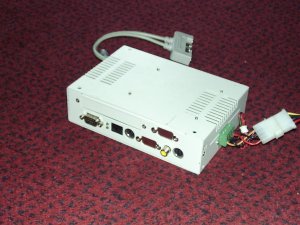 This pic shows what I was given, already prepared by the ever-geeky Dank. And here it is with an old PSU powering it. It's basically a 200MHz Pentium (the Original and um, slowest) with 32Mb of RAM and a 4Gb laptop hard disk, so no great powerhouse, but more than enough for my purposes.
This pic shows what I was given, already prepared by the ever-geeky Dank. And here it is with an old PSU powering it. It's basically a 200MHz Pentium (the Original and um, slowest) with 32Mb of RAM and a 4Gb laptop hard disk, so no great powerhouse, but more than enough for my purposes.
The original plan for a pretty custom-built case turned out to be unworkable, so the machine sat on a shelf doing nothing for a few months. Then my Playstation2 died through overuse (don't panic, I'm fine; I got another one the day after) and it struck me that the biscuit ought to fit inside it once I ripped out all the gubbins.
It turned out that with the original circuits and drive removed, the PS2 case was perfect for the job - it's seperated into 2 distinct boxes internally,
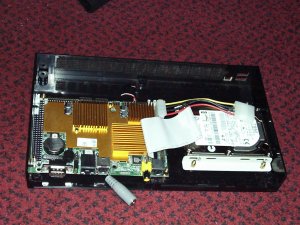
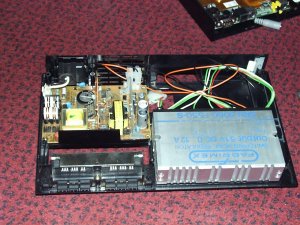 the bottom one of which now has the biscuit and hard drive in it and the top where the DVD drive used to be is now all PSU. I had to remove quite a few of the plastic knobbles and lumps that had held the original electronics in place to make room, but it was simple enough. The controller ports were left intact because I didn't need the space and it keeps it looking untouched from the outside. I was hoping to use the original PS2 power supply to drive it all, but when electronics whizz and esteemed friend DrJazz (hello, Central!) attached his Magic Multi-Meter to it he informed me we had no 5v. Luckily he had an old inverter lying around that was a perfect fit for the hole left by the drive. So the original PSU is still there for 12v and the inverter deals with the 5v. Sorted.
the bottom one of which now has the biscuit and hard drive in it and the top where the DVD drive used to be is now all PSU. I had to remove quite a few of the plastic knobbles and lumps that had held the original electronics in place to make room, but it was simple enough. The controller ports were left intact because I didn't need the space and it keeps it looking untouched from the outside. I was hoping to use the original PS2 power supply to drive it all, but when electronics whizz and esteemed friend DrJazz (hello, Central!) attached his Magic Multi-Meter to it he informed me we had no 5v. Luckily he had an old inverter lying around that was a perfect fit for the hole left by the drive. So the original PSU is still there for 12v and the inverter deals with the 5v. Sorted.
The way the biscuit fitted inside was just perfect; the connections are all available through what used to be the PS2 expansion slot
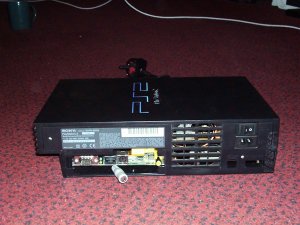 and the power inverter sits just nice inside the fascia, giving me something to blu-tak the original drive faceplate to. The only thing I felt was missing was that the power LED didn't light up anymore and as any self-respecting gadget nut will tell you, LEDs are important. Once more the intrepid and well-travelled DrJazz rescued me from my ignorance by building me a cute little board that would sent out the right voltages to make the original Sony LED light up in red when the machine is power-positive.
and the power inverter sits just nice inside the fascia, giving me something to blu-tak the original drive faceplate to. The only thing I felt was missing was that the power LED didn't light up anymore and as any self-respecting gadget nut will tell you, LEDs are important. Once more the intrepid and well-travelled DrJazz rescued me from my ignorance by building me a cute little board that would sent out the right voltages to make the original Sony LED light up in red when the machine is power-positive.
With the faceplate in place and the LED lit, it's indistinguishable from the real Playstation2 it sits on top of, which is exactly what I was hoping for. Unless it's pointed out, no-one realises there's a computer there at all.
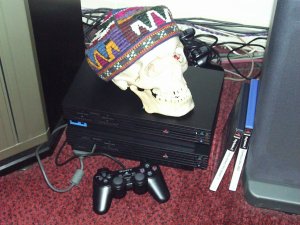
That's the hardware sorted, on to the software setup.
The biscuit is running SuSE Linux 8.1 with no X (in fact with almost everything turned off to conserve cycles) as it's OS, on top of which is the superb Music Player Daemon. The music files themselves are actually on an old PII 300 in the spare room upstairs, which is stuffed with every harddisk I could lay my hands on (around 200Gb all told) and which runs the Apache webserver and the phpMp interface for mpd. This machine is on a Fedora Core Linux OS base. So... I can open a browser on any machine in the place (the laptop is great for this), connect to the webserver on the machine upstairs and choose my music. phpMp then sends the commands to the Music Player Daemon running on the biscuit, which then plays the mp3s over an NFS share. The sound output finally goes through our Stemfoort SF100 amplifier to a pair of Celestion 7000 hybrid loudspeakers and a REL Q100E subwoofer into my distressingly hairy ears.
I'm really pleased with the way this has turned out; we now have a completely invisible digital music player with a really nice web front-end and a shedload of storage space. There are over 8000 tracks on there already, and it's about a third full. Navigating that little lot could be a complete nightmare, but the mpd/phpMp combination makes it simplicity itself.
Finally I'd like to say thank you to everyone who has helped get this sorted; Dank for the original hardware and technical support for the SuSE, DrJazz for electronical assistance, and all the talented coders all over the world who have made their work freely available to oddballs like me, who really don't deserve it.